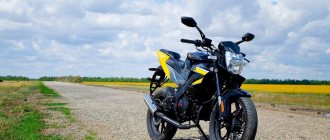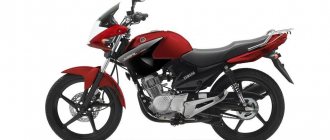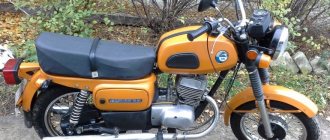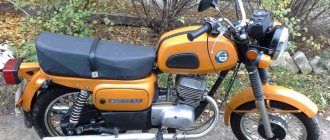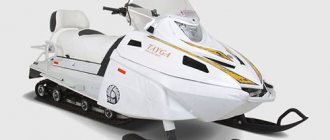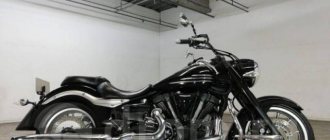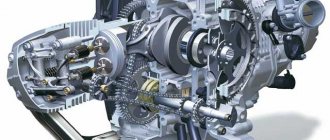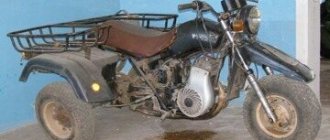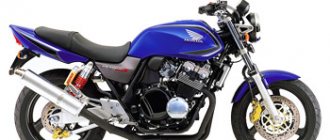The BMW K1200RS motorcycle belongs to the sport-tourist class and was in production from 1996 to 2004. Having first appeared in 1996, the model was one of the last units that had a longitudinally located internal combustion engine. Soon the K-series began to be equipped with transverse engines, but the only exception was the K1200LT. The LT version was successfully sold on the market until the beginning of 2010, but its numbers were quite small. The RS version has become more common, having slightly less power and different frame dimensions.
BMW K1200RS
Model class : sport-tourist
Years of production/sales : 1996-2004
BMW K1200RS model appeared in 1996 and was produced until 2004. This model was one of the last with a longitudinal engine, after which the K-series models received a more conventional transverse engine. The only exception is the BMW K1200LT model, which had a longitudinal engine and existed on the market until 2009.
Based on the BMW K1200RS, the BMW K1200GT (first generation) model was built in 2002.
Main generations of BMW K1200RS:
- BMW K1200RS (1996-2000) – first generation. Model code – K589 .
- BMW K1200RS (2001-2004) – second generation. Model code – K547 . The model receives minor changes to the front fairing, seat, and dashboard; new brakes (320 mm front discs, ABS II with electric brake booster) and less sporty, more touring ergonomics (the footpegs were lowered and the steering wheel became higher); Cruise control. New options available: fully integral brakes, heated seats.
Otherwise, the BMW K1200RS has the traditional features of BMW K-series motorcycles: an in-line 4-cylinder liquid-cooled engine, proprietary Telelever and Paralever suspensions, cardan drive and ABS. Touring options include: adjustable footrests, seat, clip-ons and windshield height; cruise control (since 2001), heated handles and seats (optional); availability of fastenings for side cases.
The BMW K1200RS model was produced until 2004, after which it was discontinued, leaving only the touring models K1200LT and K1200GT on the market, which later gave way to the K1300GT (since 2009) and K1600GT (since 2011).
Test drive BMWK 1200 RS, Yamaha FJR 1300 A
I can’t call myself an ardent fan of heavy tourists in general, and the BMW and Yamaha brands in particular, but the test drive itself will be all the more interesting. At first I was confused by the BMW letter indices - “RS”, which means “Road-Strasse”. How shoud I understand this? Tourist, or, nevertheless, a sports tourist? Until I saw it in person, the thought even flashed that this “Bavarian” is in no way a competitor to the “Japanese” - the K1200GT would be here... Oh, Germans, Germans... you will always “give it a blast”, and we, the Russians, will have to figure it out...
These motorcycles have only two fundamental differences, from which all others flow - the country of manufacture and the year of manufacture. If the design of the FJR breathes the East, then the Bimmer feels like a classic of the European school. But let’s not dwell too long on design delights; after all, the taste and color matter – “all bottles are different.” However, if you are interested in my personal opinion, then I like the more aggressive contours of the Yamaha, although the BMW looks brighter and richer on the road.
Where does the first acquaintance with a horse begin? From a gas station. Hay or gasoline - it doesn’t matter. It turned out to be equally easy to put motorcycles with a dry weight of “over 250” on the central stand, but I want to make a nod to the “Beemer” - it is heavier, but it rises and stands with the same effort. We refueled and sat down.
You can immediately feel that there is more tourism in FJR. The seat is more upright, the knees are slightly bent, and the body is almost perpendicular to the ground. The seat is also a little wider and a little softer than on the Bavarian. In the city this is a definite plus, but on the highway - how to say... For example, a straight landing does not allow you to lie down on the tank, thereby changing the “contact patch” of the fifth point, and driving for many hours without the ability to change position is very tiring. Much stronger than just driving for many hours.
The Yamaha's dashboard is exactly what a touring bike should have. The easy-to-read analogue speedometer and tachometer are adjacent to a large LCD display with a pleasant white backlight. It displays fuel reserve, engine temperature, outside temperature, odometer, tripmeter, clock, gear indicator, average consumption and mileage on remaining gasoline - a complete gentleman's set. BMW took a different route - instead of a display on the dashboard, under the analogue speedometer, tachometer, temperature and fuel gauge, there are as many as fourteen warning lights! It’s difficult to navigate - during the test drive I still didn’t get used to the multi-colored “garland”. To the right, a clock and a gear indicator are modestly located. As it turned out later, it is a very necessary thing on this motorcycle. Just like the standard damper.
The remote controls on the Yamaha handlebars are clear at first glance to anyone who has previously used Japanese bikes. The only “non-standard” button adjusts the height of the windshield, which is convenient. BMW remote controls are also understandable at first glance, but... only to those who have previously used motorcycles from this particular company. For example, the direction indicators are controlled by three buttons, instead of one three-position joystick. Everything would be convenient if not for one “but”: when turning right, you have to reach with your thumb to the switch, and then to the switch. All this weakens control over the throttle, which “is not good.” On the left rests modestly the cruise control controls. The remaining buttons did not cause any complaints. Yes, they are placed in a different place than on the “Japanese” ones, but this is a matter of habit. But the three-position control key for high/low beam and “blinking” deserved its share of applause - it is much more convenient to use. The windshield adjustment here is manual and only two-position – the Germans skimped on the electric lift, oh, they skimped... Maybe there wasn’t enough space on the remote controls? Although the K 1200 GT has it.
The brake, clutch and gearshift levers on both motorcycles are adjustable. But on the Beemer, this same foot is not placed very well - if you are wearing motorcycle boots, it is quite difficult to “oil” it. Or am I weird? Having somehow adjusted it to suit me, I turn the key in the BMW ignition. Start. The surroundings were filled with a rich, almost car-like hum. A Yamaha started up nearby. Wow, their sound is very similar! Having squeezed the moderately tight hydraulic clutch, I put it in first gear, add gas and... stand still. The transmission indicator still shows neutral. As it turned out, the “Bavarian” box needs a truly Aryan approach, namely, a strong kick. A soft “clack” sound is accompanied by the display of a 1 on the indicator. That's it, now you can definitely go.
The engine's thrust is simply locomotive! There is not a single hint of failure or pick-up - just powerful and smooth, like rails, acceleration, which starts from idle and goes all the way to the cutoff. At low speeds, slight vibrations are noticeable, which disappear as soon as you open the gas a little more generously. The elasticity of the engine deserves special mention - in top gear you can go both 40 and 240. If I had a hat, I would certainly take it off to the creators of this engine. If you turn on, say, second or third gear, you might think that there is an automatic transmission. The gearbox itself, by the way, deserves a low rating - gears are often not engaged, and finding neutral is not so easy - the situation is partially saved only by a “truly Aryan” approach. There are as many as six gears, as opposed to five on the Yamaha. Why there are so many is unclear. Even four would be enough, with correctly selected gear ratios.
I didn't like the mirrors either. They have decent visibility (with the correct settings, of course), but they are placed on the steering wheel and are close to the rider - this forces you not only to take your eyes off the road, but also to turn your head - a serious disadvantage in terms of safety in dense city traffic and on the autobahn, where the situation can be decided in a split second.
Good things in this life tend to come to an end, and so does the good road. But there was an opportunity to test the Bavarian’s signature suspension. By the way, there is a “teleever” in front, and a “paralever” in the back. If no adjustments were found on the front monoshock absorber, then the rear one is adjusted by preliminary compression and rebound, which I thoroughly “clamped” before the trip - fortunately, no screwdrivers or other tools are needed for this, all the “twisters” are external.
Moderate bumps were absorbed by the suspension with such ease that I could not resist and rode over them again. Amazing softness and stability are another “plus” for BMW. Next, the bumpy section of the road smoothly turned into a bumpy and winding one. Apparently, he praised it early - here the suspensions were punctured more than once, and I even got caught on one speed bump by the center stand. Although its ground clearance is almost the same as that of its competitor, for some reason it is “eaten up” much earlier.
At low speeds, the Bavarian “falls” into a turn very unpleasantly, so in order to maintain the trajectory, you have to lean heavily on the steering wheel. When moving for a long time at this pace, the arms begin to get tired, but as the “tourist” pace sets, everything changes for the better and the annoying rolliness turns into stability.
BMW brakes with power booster and integral ABS. Their power does not need advertising, and thanks to the “teleever”, the bite known to all motorcyclists is practically absent. I will only say that their tenacity can frighten an unprepared person - you can even brake with your little finger if you can reach them. But, power is power, and a larger number of elements in the linkage “lever - brake pads” make such a concept as “information content” ephemeral. But this is not so scary - after all, the likelihood of excess will be removed by softly working ABS. The true element of a touring motorcycle is a flat track with gentle “fast” turns, and I was truly glad when this element finally began. By that time, the potholes and traffic jams were boring, to put it mildly.
The Bavarian's wind protection turned out to be... interesting. Not at the expense of efficiency. Wide side trims, which made it difficult to squeeze between cars, now reliably protect the knees from the cold air, and a wide windshield fairing with a well-profiled (but low) windshield protects the chest.
The final point of the route. I say goodbye to BMW and switch to Yamaha. As I wrote above, there is a more upright and relaxed stance here. Taking a look at the mirrors, I am pleased to note that the visibility in them is much better, and they themselves are placed forward, on the fairing. I squeeze out the hydraulic clutch, which is tighter than on the Bavarian, and press on the gearbox foot. “HRRRCLATCH!!!” From surprise, I jumped straight up in the saddle! No, the box didn’t break; it signaled the inclusion of first gear.
From the very first meters of movement, I noticed more neutral handling - the motorcycle does not try to “fall” into a turn or dive out of it, and its behavior is more predictable. When driving in circles at low speed, you can hold onto the steering wheel with three fingers of one hand, while the Beemer doesn’t like this mode at all. True, the feeling of the motorcycle is worse here due to the more relaxed seating position, but this is not critical for the “tourist”. And in long-distance flights, perhaps, it is even harmful - excessive feedback quickly tires the pilot. In terms of traction characteristics, both engines are similar. On the Yamaha, I observed the same smooth, powerful thrust at any speed with a little more feedback at the top, but unfortunately, with a little less elasticity.
Wind protection here is more serious - even in the lower position, the glass removes most of the wind flow, and if you raise it up while driving at “cruising” speed, you get the feeling of falling into an air hole. Hiding behind a windshield, you can even drink a cup of coffee if you wish. But there are also disadvantages. Firstly, the rattling and vibration of the glass when driving over uneven surfaces is annoying. Secondly, the air flow it throws hits the helmet directly, creating a turbulent zone around it. I remembered that on a BMW the rider’s head is in a laminar flow - it chatters less, and it’s much quieter under the helmet.
The box, which at first confused me with its noise, turned out to be quite okay - during the test I didn’t find a single “flaw” and never missed neutral. The foot stroke and switching forces are moderate, and you can get used to the noise. In the end, the FJR engine makes it possible to remember the existence of a gearbox not very often. Suspensions are Yamaha's strong point. They are fully adjustable. Even at medium settings, they are more energy-intensive and rigid than those of BMW, brought to full “hard”. Small irregularities are swallowed by them “at once”, and in those areas where the BMW gave in, they only compressed more. If such hardness is not to your liking, then you can always adjust them softer. It's time to talk about the brakes. They, like the Bavarian, have ABS. But without an amplifier. And this is good in its own way! Here, at least, there is good information content, and their performance is quite enough to quickly take down a 350-kilogram projectile. The head light is stronger on the Yamaha - there are two double-filament lamps instead of one, but the beam is better assembled on the BMW. In addition, the Japanese have a nice feature - headlight range control units located in the cockpit.
Well, last in line (but not least) for touring motorcycles is such a factor as passenger comfort. Here, oddly enough (really, why would it be?) Yamaha wins. The “number two” saddle is as soft as the driver’s and, accordingly, softer than on the “Beemer”. In addition, it is almost straight, while the Bavarian’s passenger can slowly slide forward. The footrests are placed in approximately the same and quite comfortable positions. Motorcycle racks in this case are more or less functional, especially Yamaha ones (it’s even more convenient to hold on to), and you can put a central trunk on their mounts (without fear that it will spontaneously undock and go off on its own, generously scattering things entrusted to it along the road ). (By the way, side cases are standard equipment for the BMW K 1200 RS, but are an option for the FJR.)
conclusions
BMW K 1200 RS – sports tourer? Heavy road sport bike? Excuse me! 266 kilograms of dry weight, super-developed wind protection, a cardan, a “steam locomotive” engine, cruise control and soft suspension do not fit in with the concept of sportiness! Yes, its silhouette, at least in the rear, is more graceful, and the seating position is slightly more inclined, due to which the feeling of the motorcycle is improved - these are all the “fundamental” differences. Therefore, both bikes tested are indeed direct competitors on the aftermarket. They will easily take you anywhere in the world, provided that there is asphalt there. They are not contraindicated for driving on compacted dirt roads; they can handle even the city crowd, and on the highway they will prove themselves to be the kings of overtaking. Almost everything in them is subordinated to convenience, practicality and functionality. In addition, the mere fact of owning such a motorcycle frees you from the need to prove anything to anyone, since you already have a motorcycle, which is more than enough.
Text: Sergey Kuznetsov
Photo: Vladimir Kuznetsov
BMW K1200RS provided by Alexey Sumin
Yamaha FJR1300A provided by Vladimir Kuznetsov
Specifications
Technical characteristics of BMW K1200RS:
| Model | BMW K1200RS |
| Motorcycle type | sports tourist |
| Year of issue | 1996-2004 |
| Frame | aluminum |
| engine's type | 4-cylinder in-line, longitudinal |
| Working volume | 1172 cc |
| Bore x Stroke | 70.5x75 mm |
| Compression ratio | 11.5:1 |
| Cooling | liquid |
| Number of valves | DOHC, 4 valves per cylinder |
| Fuel supply system | Bosch Motronic MA 2.4 injector |
| Ignition type | electronic |
| Maximum power | 130 hp at 8750 rpm (98 hp at 7000 rpm - special versions for Germany and France) |
| Maximum torque | 117 Nm at 6750 rpm (118 Nm at 5500 rpm - special versions for Germany and France) |
| Transmission | 6-speed |
| type of drive | cardan |
| Front tire size | 120/70 ZR17 |
| Rear tire size | 180/55 ZR17 |
| Front brakes | 2 discs, 305 mm, 4-piston calipers (from 2001 - 320 mm, ABS II with the option of fully integral ABS) |
| Rear brakes | 1 disc, 285 mm, 4-piston caliper (ABS) |
| Front suspension | BMW Telelever, stroke - 115 mm |
| Rear suspension | pendulum BMW Paralever (preload and rebound adjustment), stroke - 150 mm |
| Overall dimensions (LxWxH) | 2250 x 850 x 1200 mm |
| Seat height | 770/800 (adjustable) |
| Gas tank capacity | 20.5 l |
| Maximum speed | 247 km/h |
| Acceleration to 100 km/h (0-100) | 3.3 sec |
| Motorcycle weight (curb) | 285 kg |
History of appearance
The BMW K1200S motorcycle has become the most long-awaited and original model released by the German company BMW over the last ten years. Back in 2004, the world community was shocked by the concern’s announcement that it was going to directly compete with Japanese manufacturers of sport bikes. The reason for this reaction lay in the unique and distinctive image of the Bavarian manufacturer: the transverse installation of a four-cylinder engine with a volume of 1200 cubic centimeters, characteristic of the Suzuki Hayabusa, Honda CBR1100XX and Kawasaki ZX-12R, would be an out-of-the-ordinary and unconventional step for BMW.
After the first presentation, invited journalists, in their reviews of the BMW K1200S, noted uneven fuel injection - until recently, a similar problem was typical for two-cylinder engines installed on the R series. The produced motorcycles had to be returned back to the factories, and production was temporarily stopped, and not the least reason for This was caused by the defect of the entire batch of incoming camshafts.
The next demonstration was held in California, and a group of American motorcycle journalists invited to the event and test drive expected a lot from the BMW K1200S.
Touring motorcycle
If we consider this motorcycle as a touring motorcycle, then in this regard it has intriguing capabilities. The fairing, which is actually a semi-fairing, confirms this. BMW has given the motorcycle excellent aerodynamics, for example, the unobtrusive deflectors bordering the fairing and tank are quite effective. They are somewhat reminiscent of the small plastic air vents on the R1200GS Adventure, which add to the comfort level of the ride. The RS windshield provides excellent protection against oncoming air flows. I liked its simple two-position adjustment. You can also install heated grips for an additional fee.
But on particularly long journeys, the RT's cocoon-like fairing and massive electronically controlled windshield would still be of better help. But additional elements of the travel kit will add 38 kg of weight. Therein lies the big question about the new R1200RS: what role will it play in the Boxer range?
BMW's tagline for the R1200RS is "the power of a sport bike and the comfort of a touring bike" and I think that's a fair assessment of the bike. The sport-tourer motorcycle segment is moving toward heavy-duty, more option-packed platforms. And BMW has its own RT model, which is a prime example of this trend. If I were asked to rate the RT as a “sport-touring”, my rating would look like this - 20% - sport, 80% - tourist, but with the RS everything is completely different.
The 17.79 liter tank makes the R1200RS feel more like a sportsbike than a touring bike (the RT's 25 liter fuel tank, for example). With the same fuel efficiency as the R model of 17 kilometers per liter, the RS is claimed to be with a fully filled tank it will cover 322 km. But, it seems to me that the driver will have to refuel every 240-260 km.
But riders can rest assured that they will be well informed about fuel levels and a host of other indicators by reading them on the R1200RS instrument panel. On the left is an analogue speedometer, next to which is a TFT display. The display is easy to read and displays a wealth of essential information such as gear changes, timing, as well as Ride Mode and ESA settings. And on the RS display, which is also available on the R model, you can choose from three styles of displaying information. This is a very original feature. You may think that this is all too confusing and not much is needed... So many options, buttons and all that... Well.. If we talk about the importance and necessity of some options, then on the RS you can also purchase the Keyless Ride option for an additional cost, which, I thought it should allow you to start the motorcycle without a key, but in order to start the motorcycle you still need to turn the key. Therefore, I, as a simple person, cannot appreciate the advantages of such systems and for some reason their meaning and importance are not at all clear to me.
Some people may not like the styling of the BMW R1200RS, but I liked its lines, especially the blue-gray color scheme that the bike I rode had. The build quality and finish of the motorcycle is luxurious. The most inexpensive configuration of this motorcycle is the Standard Package. The more expensive package is called the Premium Package. The number of options varies depending on the configuration. For an additional cost, you can also purchase the Style 2 Package, which has beautiful changes to the appearance of the motorcycle such as gold painted calipers, a stainless steel tank cover, an engine spoiler, and a gray frame.
Riding the BMW R1200RS for a full day showed that I could really enjoy riding it. It's the kind of bike that will probably go unnoticed by most riders, but I suspect the sizeable contingent of Boxer fans eagerly awaiting the new R1200RS won't be disappointed. The RS joins the versatile R-Series lineup as a legitimate, great touring bike.
Price
An undoubted advantage noted in reviews of the BMW K1200S is a fairly extensive package of additional options, including the BMW ESA electronic suspension adjustment system, an anti-lock braking system and two-tone body colors. In the basic modification, the motorcycle was offered for 900 thousand rubles from American dealers. A luggage transport kit consisting of side cases and a fuel tank bag is available as accessories.
Reviews from BMW K1200S owners
The changes made to the design of the motorcycle provide an excellent opportunity even for novice drivers to feel like professional sportbike pilots, flying straight sections of tracks at high speed and taking turns without pressing the brake. The characteristics of the motorcycle were tested during a 400-kilometer test drive: the route passed along the roads of Northern California. The pilots who tested the BMW K1200S were satisfied with the car: the Bavarian company managed to create a unique and stunning sports bike that could outshine its Japanese competitors.
